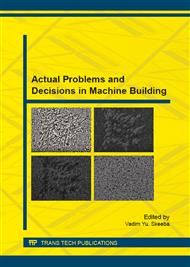p.136
p.143
p.151
p.157
p.163
p.170
p.177
p.182
p.187
Effects of Heating Atmosphere on Structure and Thermal Expansion of Aluminum Alloys
Abstract:
This paper analyses effects of boiling treatment of aluminum alloys (Al–(5-10)% Cu and Al–(5-10)% Si) in oxidizing atmosphere on their microstructure, hydrogen content and coefficient of linear thermal expansion (CLE). Boiling treatment was conducted in water solutions of KMnO4 and KOH. Following an increase of boiling time from 15 to 75 hours hydrogen content in alloys first increases and then decreases which correlates with the dynamics of alloys’ microstructure and their coefficient of linear expansion. This study shows that atmosphere with high oxygen content induces acceleration of diffusion processes in aluminum alloys. If boiling time does not exceed 30 hours, hydrogen content in solid solution and etchability of grain boundaries of α-solid solution decrease and intermediate phases get partially dissolved. In our empirical study we demonstrated that boiling treatment of aluminum alloys in oxidizing atmosphere in the range of test temperatures 50-450°С leads to a reduction of the coefficient of linear expansion. The decrease of the coefficient of linear expansion is especially strong in the temperature range of 250-350°С. In particular, after boiling treatment of alloys Al–(5-10)% Cu in oxidizing athmosphere in the temperature range of 50–250°С their coefficient of linear expansion goes down by 10-12%. For alloys Al–(5-10)% Si boiling has a stronger effect on the coefficient of linear expansion – in the temperature range 250-350°С the CLE of these alloys decreases by 24-28%.
Info:
Periodical:
Pages:
163-169
Citation:
Online since:
August 2015
Authors:
Price:
Сopyright:
© 2015 Trans Tech Publications Ltd. All Rights Reserved
Share:
Citation:


